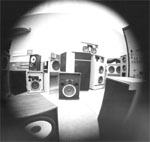My goal is to use DSP to get the L300s to sound better. I have always enjoyed the L300s but as most of us know there are phase and timing issues between the woofer and the HL92 due to its length. Also equalization has to be performed with an outside unit. With DSP a delay in timing is easier. Also crossover settings can be changed in a matter of seconds and equalization can be changed rapidly. driver polarity can be changed easily. I also want to swap the 136As and 2216NDs to see which sound better in this configuration.
My first concern is to protect the drivers which I may be able to do with capacitors. I noticed in the M2 what JBL calls a crossover appears more to protect the compression driver than anything else. Early on I almost learned this lesson the hard way when I was using a trial version of TrueRta. I failed to notice that the sweeps started at 10hz. When I executed the sweep I saw the 2235s violently move back in forth until the cone broke free of the surround. Luckily, I was able to put on new surrounds and after sweeping the driver all was well. Point being if you don't pay careful attention, dsp can damage or destroy a irreplaceable driver.
I researched the forum and the internet for information so far can't find much on this type of implementation with the L300; so I am going to start from scratch. Anytime you stray from engineering specifications it will not be a walk in the park. This will be time consuming as I will have to take careful measurements as I make changes to see if I am heading in the right direction. I was fortunate on the M2 project since most of the settings and adjustments were provided by forum members.
The 2216NDs won't be in till the middle of February. The MiniDsp flex eight will be in Saturday. In the mean time I am trying to find at all I can about the L300 and DSP.
I do have a question. The original L300 was crossed at 800 and 8500. It appears a 12db/octave slope on the low section and a 18db/octave is this correct, also was a Butterworth or a Linkwitz-riley used?
Any thoughts or comments would be appreciated.
Regards
Al




 Reply With Quote
Reply With Quote





